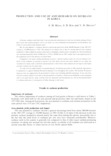Production and Use of and Research on Soybeans in Korea
Tropical agriculture research series : proceedings of a symposium on tropical agriculture researches
| ISSN | 03889386 |
|---|---|
| NII recode ID (NCID) | AA00870529 |

Full text
tars17-_81-93.pdf1.59 MB
In Korea, soybeans rank third both in the area planted and production after rice and barley among all food grain crops and soybean products such as soy paste, soy sauce, beancurd and beansprouts are the primary side dishes in conventional daily Korean meals.
But the area planted to soybeans showed a decreasing trend from about 300,000 hectares of the 1967-1971 average to 183,000 hectares in 1982. The reduction was mainly due to the low income derived from soybeans compared to other competing summer crops such as red-pepper, sesame, potato, and garlic, etc. National demand also increased drastically from 319,000 tons in 1973 to 769,000 tons in 1982, mainly due to the rapid increase in the population and in the amount of animal feeds.
Compared to the major soybean-producing countries, national soybean yields are very low because two-thirds of the soybeans are planted as second crop after barley harvest and many farmers do not make any investment for inputs such as fertilizers and protectants as they believe that soybeans do not require such inputs and that soybeans are not cash crops.
To cope with the rapid increase of national demand, the Korean goverment in 1983 asked the Agricultural Cooperatives to organize Soybean Production Increase Units throughout the country. The Soybean Production Increase Units are supported by the government in many ways including subsidies and prizes. At the same time, national soybean research is focussed on the development of soybeans which can be utilized for various purposes such as soy paste and soy sauce, cooking with rice, beancurd, and beansprouts, etc. and on the mechanization of soybean cultivation in anticipation of labor shortage in the future.
But the area planted to soybeans showed a decreasing trend from about 300,000 hectares of the 1967-1971 average to 183,000 hectares in 1982. The reduction was mainly due to the low income derived from soybeans compared to other competing summer crops such as red-pepper, sesame, potato, and garlic, etc. National demand also increased drastically from 319,000 tons in 1973 to 769,000 tons in 1982, mainly due to the rapid increase in the population and in the amount of animal feeds.
Compared to the major soybean-producing countries, national soybean yields are very low because two-thirds of the soybeans are planted as second crop after barley harvest and many farmers do not make any investment for inputs such as fertilizers and protectants as they believe that soybeans do not require such inputs and that soybeans are not cash crops.
To cope with the rapid increase of national demand, the Korean goverment in 1983 asked the Agricultural Cooperatives to organize Soybean Production Increase Units throughout the country. The Soybean Production Increase Units are supported by the government in many ways including subsidies and prizes. At the same time, national soybean research is focussed on the development of soybeans which can be utilized for various purposes such as soy paste and soy sauce, cooking with rice, beancurd, and beansprouts, etc. and on the mechanization of soybean cultivation in anticipation of labor shortage in the future.
| Date of issued | |
|---|---|
| Creator | E. H. HONG S. D. KIM Y. H. HWANG |
| Publisher | Japan International Research Center for Agricultural Sciences |
| Volume | 17 |
| spage | 81 |
| epage | 93 |
| Language | eng |
